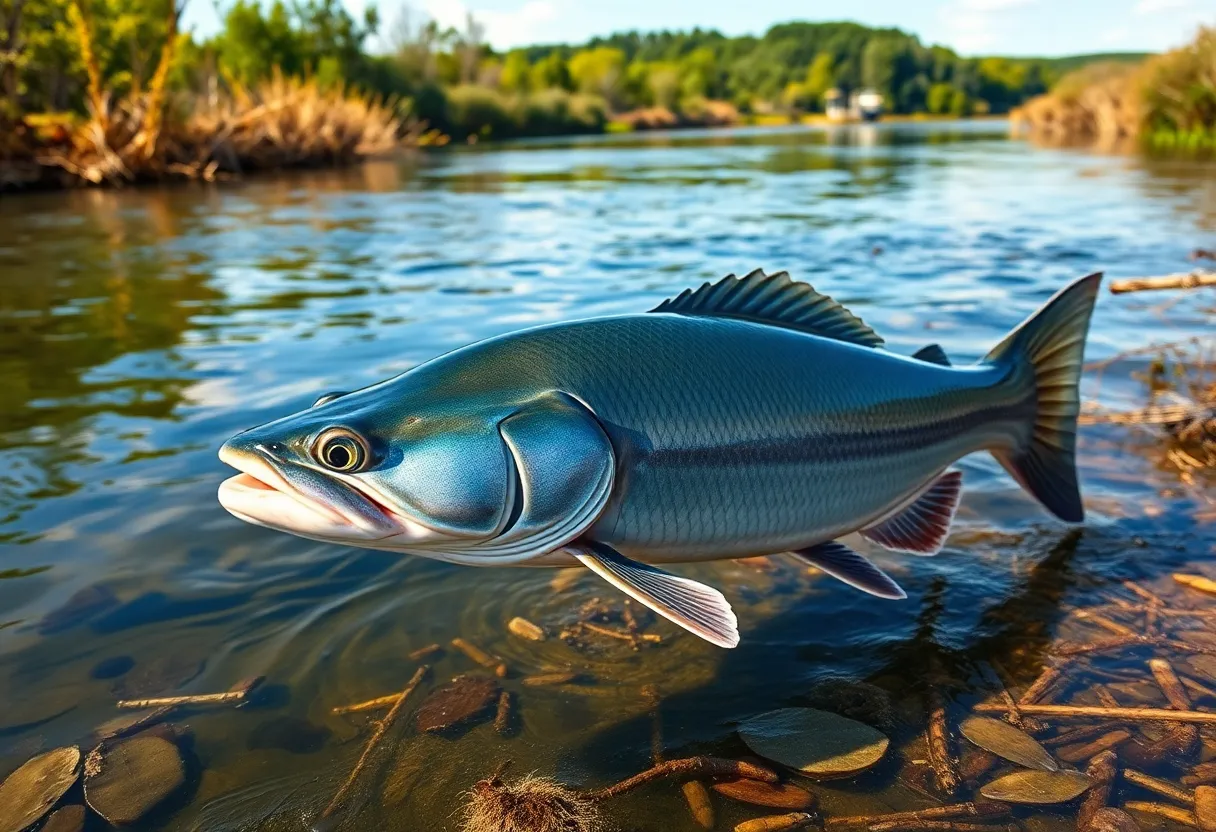Omaha, October 21, 2025
Mike Reynolds, a local angler from Omaha, made headlines after catching a record-breaking blue catfish weighing 104 pounds in the Missouri River. This remarkable catch not only surpasses the previous state record by nearly 20 pounds but also emphasizes the importance of ongoing conservation efforts in the region. Reynolds, a Creighton University alumnus, plans to host angling clinics to promote sustainable fishing practices among local youth, further igniting community interest in outdoor activities and environmental stewardship.
Omaha, NE
Cheers erupted across Omaha as local angler Mike Reynolds reeled in a record-breaking blue catfish weighing 104 pounds from the Missouri River near the Iowa-Nebraska border. This massive catch, verified by Iowa Department of Natural Resources officials, shatters the previous state record by nearly 20 pounds. The event occurred within the last 48 hours and has sparked widespread excitement among fishing communities and environmental enthusiasts in the region.
The Historic Catch
Reynolds, a 45-year-old Creighton University alumnus and avid fisherman, battled the enormous fish for over an hour using a traditional trotline. The struggle took place in the murky waters of the Missouri River, where strong currents and the catfish’s size made the task particularly challenging. Upon landing the fish, Reynolds immediately contacted officials for verification, ensuring the record’s legitimacy. The blue catfish measured over five feet in length, showcasing the impressive growth potential in the river’s ecosystem.
Connection to University Athletics and Local Programs
As a Creighton University graduate, Reynolds attributes part of his success to skills honed during campus fishing trips, blending his love for the outdoors with his educational background. This personal story has resonated with university communities, particularly in athletics circles, where outdoor activities often intersect with team-building and recreational programs. The achievement coincides with heightened interest in the river’s ecosystem, boosted by recent conservation efforts led by regional universities.
Environmental Implications
University of Nebraska-Lincoln biologists have hailed the event as a positive indicator of improving water quality in the Missouri River. Over the past several years, initiatives to reduce pollution and restore habitats have led to healthier fish populations. The presence of such a large blue catfish suggests that these efforts are paying off, allowing species to thrive in ways not seen for decades. This development is particularly relevant for university athletics programs that incorporate environmental education, such as rowing teams practicing on the river or ecology-focused student groups.
Community Response and Educational Outreach
The record-breaking catch has inspired local initiatives to engage youth in outdoor education. Creighton University is hosting free angling clinics this week to celebrate the achievement and promote safe, sustainable fishing practices. These events aim to teach young participants about patience, environmental stewardship, and the importance of conservation, drawing parallels to the discipline required in athletic pursuits. Reynolds plans to mount the head of the catfish as a trophy while releasing the rest of the fish back into the wild, emphasizing a commitment to preserving the species.
Broader Context of Fishing Records
Blue catfish are native to the Mississippi River basin, including the Missouri River, and are known for their adaptability and rapid growth. The previous Iowa state record stood at 85 pounds, set in 2020, making Reynolds’ catch a significant milestone. Such records not only highlight individual accomplishments but also underscore the health of regional waterways. In recent years, similar breakthroughs in fish sizes have been reported along the Iowa-Nebraska border, correlating with collaborative efforts between state agencies and academic institutions to monitor and protect aquatic life.
Impact on Local Fishing Communities
Fishermen in Omaha and surrounding areas view this event as a boost to local morale and interest in angling as a recreational sport. Trotlines, the method used by Reynolds, are a time-honored technique in the Midwest, involving lines with multiple baited hooks suspended across the current. The success story has prompted discussions on best practices for handling large catches, ensuring minimal stress to the fish during release. University athletics departments, often involved in community outreach, may integrate similar stories into their programs to encourage student participation in non-traditional sports like fishing.
University Ties and Future Prospects
The connection to Creighton University ties this feat to the broader landscape of college athletics, where alumni achievements often inspire current students. Reynolds’ experience on campus fishing trips illustrates how universities foster lifelong hobbies that promote physical fitness and mental resilience—qualities essential in competitive sports. As conservation efforts continue, experts anticipate more record-breaking catches, potentially drawing national attention to the Missouri River’s revitalization. This could lead to expanded partnerships between universities and conservation groups, enhancing educational opportunities for athletes and non-athletes alike.
The record catch serves as a timely reminder of the intersection between personal triumphs, environmental health, and community engagement in the heartland. With ongoing monitoring by biologists and increased public interest, the Missouri River remains a vital resource for recreation and study in the Omaha area.
FAQ
What is the weight of the record-breaking blue catfish caught by Mike Reynolds?
The record-breaking blue catfish caught by Mike Reynolds weighs 104 pounds.
Where was the blue catfish caught?
The blue catfish was caught from the Missouri River near the Iowa-Nebraska border.
Who verified the record-breaking catch?
The record-breaking catch was verified by Iowa Department of Natural Resources officials.
How much does this catch exceed the previous state record?
This catch shatters the previous state record by nearly 20 pounds.
What method did Mike Reynolds use to catch the fish?
Mike Reynolds used a traditional trotline to battle the fish for over an hour.
What are Mike Reynolds’ plans for the fish?
Mike Reynolds plans to mount the head and release the fish back into the wild.
How has the University of Nebraska-Lincoln responded to the catch?
University of Nebraska-Lincoln biologists hailed the event as a sign of improving water quality.
What community initiatives have been inspired by the catch?
Creighton University is hosting free angling clinics this week to celebrate the achievement and promote outdoor education.
Key Features Chart
| Feature | Details |
|---|---|
| Weight of Catch | 104 pounds |
| Location | Missouri River near Iowa-Nebraska border |
| Verification | Iowa Department of Natural Resources |
| Record Excess | Nearly 20 pounds over previous |
| Catching Method | Traditional trotline, over 1 hour battle |
| Angler Background | 45-year-old Creighton University alumnus |





